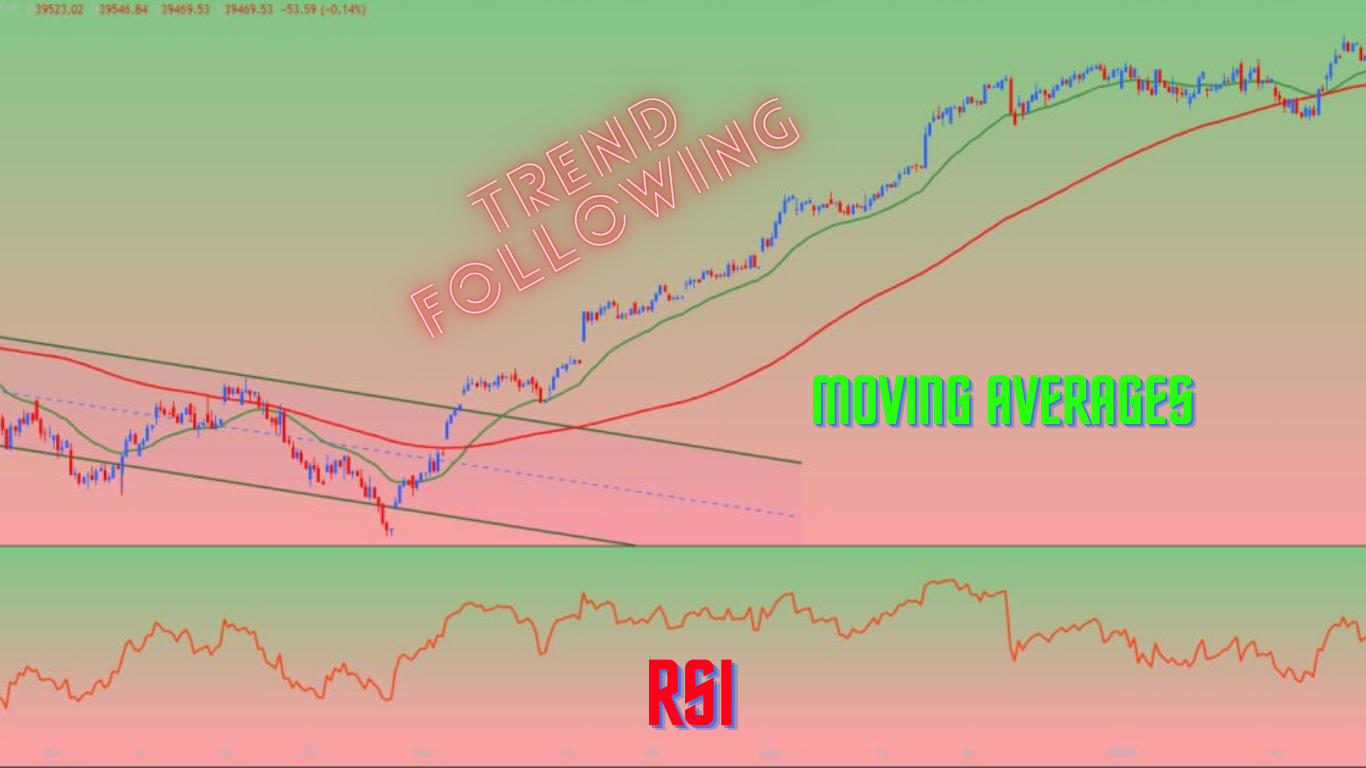Trend Following Strategies for Trend Riders:
Trend following is a popular trading method that involves identifying and trading in the direction of market trends. By aligning your strategies with prevailing market conditions, you can take advantage of price movements and maximize your potential profitability.
- Whether you are a novice trader or an experienced investor, understanding trend following can be crucial to your trading success.
- To effectively implement trend following strategies, it is important to conduct thorough market trend analysis. This involves studying charts, analyzing historical data, and identifying patterns that indicate the direction of the market.
By gaining insights into market trends, you can make informed trading decisions and increase your chances of success.
- Trend indicators and signals play a critical role in trend following. These tools help traders identify when a trend is beginning, continuing, or reversing.
By utilizing trend indicators and interpreting trend signals accurately, you can improve your timing and increase the profitability of your trades.
- Understanding the different types of trend indicators and how they can be used in conjunction with trend following strategies is essential for traders.
- Whether you are interested in trend trading as a long-term investment strategy or as a short-term trading approach, mastering trend following techniques is a valuable skill.
- By incorporating key components of trend following, such as identifying trend reversals, tracking trends over time, and taking advantage of momentum trading, you can enhance your ability to follow market trends and make profitable trading decisions.
- This journey to master trend following strategies and unlock your trading potential. By leveraging market trends, utilizing trend indicators and signals, and incorporating effective trend following techniques, you can position yourself for trading success.
Important Details :
- Trend following strategies are effective in capitalizing on market trends and improving trading outcomes.
- Conducting market trend analysis is crucial for making informed trading decisions.
- Trend indicators and signals help identify and confirm market trends.
- Mastering key components of trend following strategies, such as identifying trend reversals and leveraging momentum trading, can enhance trading success.
- By incorporating trend following techniques, traders can position themselves for profitable trades and capitalize on market momentum.
Understanding Trend Following and its Benefits
Trend following is a trading approach that capitalizes on market trends and allows traders to agree their strategies with prevailing market conditions.
- By following the direction of the market and identifying trends, traders can take advantage of market movements and improve their trading success.
- Trend following is based on the core principle that markets tend to move in trends, either upward or downward, for extended periods of time.
- By identifying these trends and riding the momentum, traders can increase their profitability and minimize the risks associated with counter-trend trading.
- Trend following is based on the core principle that markets tend to move in trends, either upward or downward, for extended periods.
- By identifying these trends and riding the momentum, traders can increase their profitability and minimize the risks associated with counter-trend trading.
The Benefits of Trend Following
Trend following offers several benefits that can enhance your trading outcomes:
- Increased Probability of Profit: By aligning your trades with the dominant market trend, you increase the likelihood of capturing profitable moves and avoiding false breakouts or reversals.
- Reduced Emotional Decision-Making: Trend following strategies rely on objective rules and indicators, eliminating the need for impulsive, emotion-driven trading decisions.
- Minimized Risk of Over trading: By focusing only on high-probability trade setups that align with the trend, you can avoid excessive trading and prevent unnecessary losses.
- Clear Entry and Exit Signals: Trend following strategies utilize specific indicators that provide clear signals for entering and exiting trades, improving your timing and execution.
By understanding and implementing trend following strategies, you can position yourself to profit from market trends and achieve consistent trading success.
Key Components of Successful Trend Following Strategies
Trading success in the dynamic financial markets relies heavily on implementing effective trend following strategies.
- By understanding and utilizing key components such as trend reversal identification, trend tracking techniques, and leveraging market momentum, traders can significantly enhance their ability to follow trends and make well-informed trading decisions.
Techniques for Identifying Trend Reversals
Identifying trend reversals is crucial for trend following strategies as it allows traders to catch shifts in market sentiment and capitalize on new opportunities.
- Traders can employ various technical analysis tools and indicators, including moving averages, chart patterns, and oscillators, to identify potential reversals.
- By carefully analyzing price patterns and volume fluctuations, traders can gain valuable insights into trend reversals and adjust their trading positions accordingly.
Tracking Trends Over Time
Tracking trends over time is a fundamental aspect of successful trend following strategies.
- Traders can use trend indicators, such as the moving average convergence divergence (MACD) or the average directional index (ADX), to assess the strength and duration of a trend.
- By monitoring these indicators and analyzing price action, traders can index the health of a trend and make informed decisions on whether to enter, exit, or hold a position.
Leveraging Momentum for Profitable Trades
Momentum trading is a key element of trend following strategies that involves capitalizing on the continued price movement in the direction of an established trend.
- Traders can utilize momentum indicators like the relative strength index (RSI) or the stochastic oscillator to identify overbought or oversold conditions and determine optimal entry or exit points.
- By riding the wave of momentum, traders can maximize their profit potential and mitigate the risk of entering trades against the prevailing trend.
- It is important to note that successful trend following strategies are not foolproof and require continuous monitoring and adjustment.
- Traders should always combine technical analysis with proper risk management strategies to ensure long-term trading success.
Utilizing Trend Indicators and Signals
When it comes to trend following, trend indicators and signals play a crucial role in helping traders identify and confirm market trends.
- By understanding and mastering the use of these indicators, you can significantly improve your trading outcomes and increase your success rate.
- There are various popular trend indicators and tools available that can assist you in analyzing market trends effectively.
- These indicators are designed to highlight the direction and strength of trends, providing valuable insights for trend following strategies.
- By incorporating these indicators into your trading approach, you can enhance your ability to make informed decisions.
- One such popular trend indicator is the moving average. Moving averages smooth out price fluctuations and help identify the direction of the trend.
- They can be used as dynamic support or resistance levels.
- By analyzing the relationship between different moving averages (such as the 50-day and 200-day moving averages), traders can identify potential trend reversals or confirm ongoing trends.
- Another widely used trend indicator is the relative strength index (RSI). The RSI measures the speed and change of price movements, indicating whether a market is overbought or oversold.
- This information can signal potential trend reversals or confirm the strength of an ongoing trend.
Interpreting Trend Signals
Understanding and interpreting trend signals is essential for effective trend following. Trend signals are generated when trend indicators provide specific indications of a potential trend change or continuation.
- For example, a bullish trend signal may occur when the price crosses above a moving average, indicating a potential upward trend.
- On the other hand, a bearish signal may occur when the price crosses below a moving average, suggesting a potential downward trend.
- By combining the use of trend indicators with the interpretation of trend signals, traders can develop a comprehensive approach to trend following.
- This approach enables them to effectively time their trades, increasing the likelihood of profitable outcomes.
Trend Indicator :
- Moving Averages :- Smooths out price fluctuations, provides trend direction
- Relative Strength Index (RSI) :- Measures price speed and change, indicates overbought or oversold conditions.

- By utilizing trend indicators and signals, you can enhance your trend following strategies and navigate the dynamic nature of the markets.
- These tools provide valuable insights and assist in identifying potential trend reversals or confirming ongoing trends, improving your ability to make profitable trading decisions.
Conclusion
- In conclusion, mastering trend following strategies is crucial for achieving trading success.
- By understanding market trends, incorporating key components of trend following, and utilizing trend indicators and signals, you can position yourself for profitable trades and capitalize on market momentum.
- Trend following combines the analysis of market trends with strategic trading approaches to maximize profit potential.
By identifying and tracking trends, you can make informed trading decisions that align with the prevailing market conditions.
This approach allows you to ride the wave of market momentum and take advantage of profit opportunities.
- Utilizing trend indicators and signals is a vital aspect of trend following.
- These tools help in identifying and confirming trends, giving you a reliable basis for your trading decisions.
- By mastering the use of trend indicators and interpreting trend signals effectively, you can improve the timing of your trades and increase your success rate.
- Embark on a journey to enhance your trading skills and achieve your financial goals by mastering trend following.
- By staying updated on market trend analysis, incorporating key components of trend following, and utilizing trend indicators and signals, you can position yourself for sustainable trading success.
Frequently Asked Questions :
What is trend following?
Answer :
- Trend following is a trading strategy that aims to capitalize on market trends by buying or selling an asset based on its current price movement.
- Traders following this approach believe that trends tend to persist over time and focus on riding the trend until it shows signs of reversal.
Why is trend following beneficial?
Answer :
- Trend following can be beneficial because it allows traders to align their strategies with the prevailing market conditions.
- By following the trend, traders can potentially capture substantial profits as long as the trend remains intact, significantly improving their trading success.
How can I identify trend reversals?
Answer :
- Identifying trend reversals can be done using a variety of technical analysis tools such as moving averages, trend lines, or oscillators.
- These indicators can help traders spot potential changes in trend direction or market sentiment, enabling them to adjust their trading strategies accordingly.
What is trend tracking?
Answer :
- Trend tracking refers to the process of continuously monitoring and analyzing market trends to identify profitable trading opportunities.
- Traders engaging in trend tracking keep a close eye on price movements, trend indicators, and other relevant market factors to stay ahead of market trends.
How can momentum trading benefit trend following?
Answer :
- Momentum trading, which focuses on the strength and speed of price movements, can complement trend following strategies.
- By identifying assets with strong momentum in the direction of the prevailing trend, traders can increase their chances of entering profitable trades and maximizing their returns.
What are trend indicators and how can they help?
Answer :
- Trend indicators are technical analysis tools that help traders identify and confirm market trends.
- Examples of trend indicators include moving averages, trend lines, and the Average Directional Index (ADX).
- By using these indicators, traders can gain insights into the strength and direction of the trend, enhancing their trading decisions.
How do I interpret trend signals?
Answer :
- Interpreting trend signals involves analyzing the information provided by trend indicators or other technical analysis tools.
- For example, a bullish trend signal may suggest a buying opportunity, while a bearish trend signal may indicate a potential selling opportunity.
- It is essential to understand the context and confirm signals with additional analysis before making trading decisions.








